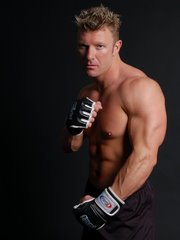| ROAD MAP TO HUGE ARMS Arm workouts going nowhere? Green-light rapid growth with M&F’s eight-week guide to sleeve-busting bi’s and tri’s Story by: BILL GEIGER, MA, AND JIM STOPPANI, PHD |
DESTINATION: BIG ARMS
The superhighway to thicker arms requires a workout tune-up. First, instead of training arms just once over the course of your split, now you’ll work them twice. Training muscle groups more frequently stimulates genes in the muscle cells that instigate muscle growth. More frequent workouts (to a point) keeps those genes stimulated longer for better muscle growth.
On Saturday (see training split), you’ll hit your biceps and triceps in one session with a variety of exercises and rep ranges. In this split, Saturday follows a rest day. Whatever sequence you use, make sure your main arm day is after a rest day so you’re fresh and can devote full energy to your training. This enables you to go heavier and achieve greater intensity.
On Monday, after your chest workout, you’ll hit the triceps with a single bread-and-butter move to finish them off — after all, they’ve been getting more than their share of the workload in heavy pressing moves. The same goes for the biceps: On Tuesday, you’ll do a single exercise after back training to increase the blood flow to the bi’s and engorge them.
GPS TO ARM SIZE
You can overtrain your arms if you do too much work for too long, so return to your regular training split after eight weeks. Introducing change into your routine in this manner creates the opportunity for improvement, but it doesn’t continue indefinitely. Keep in mind that your ultimate arm size is also related to your genetic potential, although many of us never reach it because we lack patience, persistence and the know-how to get there.
Since it’s nearly impossible to build bigger arms when dieting down, you must consume enough overall calories and protein to not only sustain you during your training sessions but guarantee muscle growth as well. This means not missing meals, following a smart supplementation plan to ensure you get the required muscle-building nutrients, and paying attention to your pre- and postworkout meals. In tandem with this training routine, follow the “Road Map to Huge Arms” diet and supplement program that begins on page 130.
Ultimately, you’ll reach your final destination of bigger bi’s and tri’s faster if you follow a map to get there. While there are no shortcuts for hard work, at least you won’t be spinning your wheels following a random or haphazard plan. And that can only mean a green light for growth!
Download the full pdf version of this article, print and take it to the gym.
pdf ZIP (win) file
pdf STUFFIT (mac) file




























